Pilgrims and visitors eagerly wait for the day when the door of Badrinath dham is opened for the public for darshan of Lord Badrinarayan. Once the strine is opened, devotees and tourists throng in large numbers and the quaint hilltop town suddenly bustles with activities. While the main purpose of most of the visitors is darshan of Lord Vishnu at the sacred Badrinath dham, they leave no stone unturned to explore the unmatched natural beauty of the place. The picturesque town of Badrinath is undoubtedly the meeting place of divine and nature.
The pre-eminent abode of Lord Vishnu, sits at a height of 3,133 metres in the Chamoli district of Uttarakhand, is one of the holiest of the holy shrines of the main Char Dham pilgrimage in India. Other Char Dham sites include Dwarka, Puri, and Rameswaram.
The sacred land of Vishnu, nestled between the Nar and Narayan peaks, is also a part of the Chota Char Dham Yatra in Uttarakhand. Starting with Yamunotri, Gangotri, and Kedarnath, Badrinath is the last and most famous site on the pilgrimage tour of the Garhwal Himalayas. Badrinath Dham is easily accessible along motorable roads, and the Badrinath temple is within walking distance from the parking lot. This year, the temple has already been opened for visitors since May 8, 2022.
However before embarking on a visit to Badrinath shrine, you need to know about its history, legends and several other features. In this post I will talk at length regarding all you need to know about Badrinath shrine.
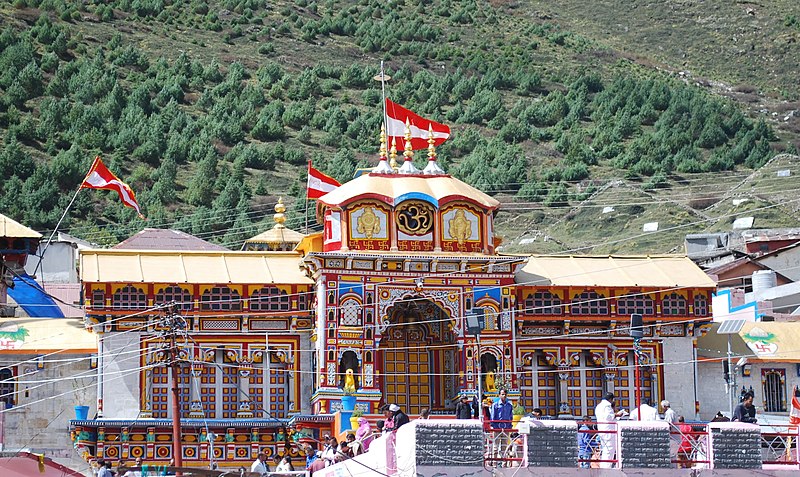
Post Contents
History and legends
Though there are no definite historical records, It is commonly assumed that Adi Shankara, a great Indian philosopher and saint who revitalized Hinduism by integrating its beliefs into a theory known as Advaita Vedanta, founded the Badrinath temple in the 9th century. However, due to its obviously Buddhist style and brilliantly coloured façade, some claim that the shrine already existed as a Buddhist temple.
Nonetheless, it is widely acknowledged that Adi Shankara discovered the temple’s fossilised black stone image of Lord Vishnu (as Lord Badrinarayan) in the Alaknanda River. The idol is regarded as one of India’s eight major Svayam Vyakta Kshetras—idols of Lord Vishnu that emerged on their own accord and were not made by anyone.
From 814 to 820 AD , Adi Shankara lived in the Badrinath temple. He also appointed a Nambudiri Brahmin chief priest from Kerala, India, where he was born. Even though the temple is in north India, the tradition of having a priest from Kerala prevails. The rawal, or priest, is chosen by the former rulers of Garhwal and Travancore.
Since the 9th century, the Badrinath temple has experienced different modifications and restorations, with the inner sanctum probably being the only original existing feature. The temple was expanded by Garhwal rulers in the 17th century, giving it its current structure. In the 18th century, Maratha queen Ahilyabai Holkar of Indore coated its spire in gold. The temple was devastated by a major earthquake in the early 19th century and was later reconstructed by the royal family of Jaipur.
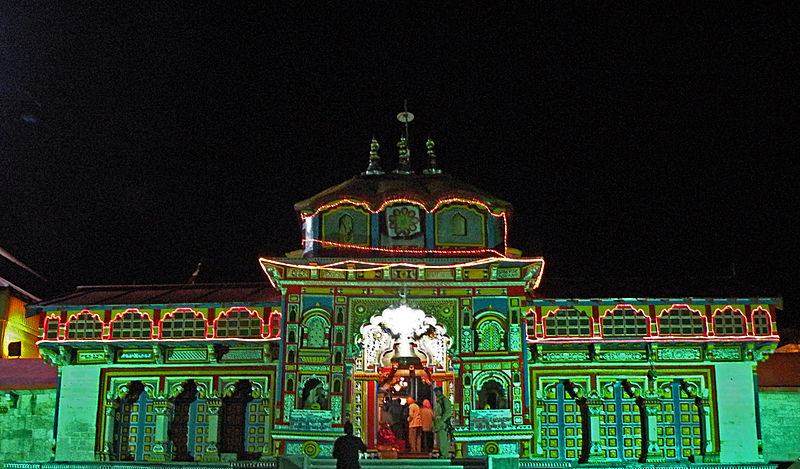
Do read: How to plan your Badrinath Trip-A complete guide
Legends about Badrinath temple
The name Badrinath comes from the native word badri, which refers to a variety of wild berries (Jujube). When Lord Vishnu sat in penance in these mountains, it is
stated that his consort Goddess Laxmi took the form of a berry tree and sheltered him from the harsh weather. It is not only the abode of the lord, but also the home of countless pilgrims, saints, and sages who come here to contemplate in search of enlightenment.
Badrinath is a region rich in religious accounts from several ancient Hindu scriptures. The puranic story of the Pandav brothers and Draupadi travelling through on their last pilgrimage by ascending the slopes of a peak near Badrinath called Swargarohini, or the ‘Ascent to Heaven,’ or the visit by Lord Krishna and other great sages, are just a few of the many stories associated with this holy place.
Great sages such as Kapila Muni, Gautam, and Kashyap performed penance here, Bhakta Narada attained salvation, and Lord Krishna adored this region, and mediaeval religious scholars such as Adi Shankaracharya, Ramanujacharya, Sri Madhavacharya, and Sri Nityananda came here for learning and quiet contemplation, as do many people today.

Badrinath temple architecture
The architecture of Badrinath temple follows the traditional North Indian style. The temple is built of stone, with intricate carvings on the walls and pillars. A tall arched gateway at the entrance leads to Sabha Mandap (hall where devotees congregate), which leads to Darshan Mandap (place where Pooja to the idol is performed), and finally to Garbhagriha (sanctum sanctorum).
The roof of the Garbha Griha extends to a 15-metre-high conical spire with a gold-gilded dome on top. A striking 1 metre high black stone idol of Badrinarayan presides over the sanctum sanctorum, with a conch and Chakra in each arm. The other two arms are resting in the lap of Vishnu, who is meditating in the Padmasana posture. Sage Narada is present, as is his consort Lakshmi. The temple takes its full form with Kubera on one side and Nar Naryan and Uddhava on the other. Garuda and Navdurga are also present.
The temple however, was believed to be a Buddhist shrine until the 8th century, when Adi Shankara revived it and converted it to a Hindu temple. The temple’s architecture is similar to that of a Buddhist vihara (temple), as is its brightly painted facade, which is typical of Buddhist temples.
Poojas and aarti in Badrinath shrine
The schedule at Badrinath temple begins early in the morning at 4.30 a.m. with Pujas called Maha Abhishek and Abhishek of the presiding deities. Indeed, the schedule concludes at 9 pm. with Shayan Aarti. There are various types of special pujas that take place throughout the day, such as Ved Path and Geeta Path, which take place between 6.30 am and 12 pm and 3 pm. Later in the day, one can perform Badrinath Special Poojas such as the Srimad Bhagwat Saptah Path, Evening Aarti, Swarna Aarti, Vishnusahasranam, Kapoor Aarti, and Shayan Aarti.
To complete the Puja, devotees must take a dip in Tapt Kund and be led by a priest from the special Rawal group. After the Maha Abhishek and Abhishek Puja at Badrinath temple, it opens to the general public at around 8 am. and closes at 1 pm. This is followed by a short break from 1 to 4 pm., after which the temple reopens to the public until 9 pm. After reciting the divine song Geet Govind, the temple doors are closed.
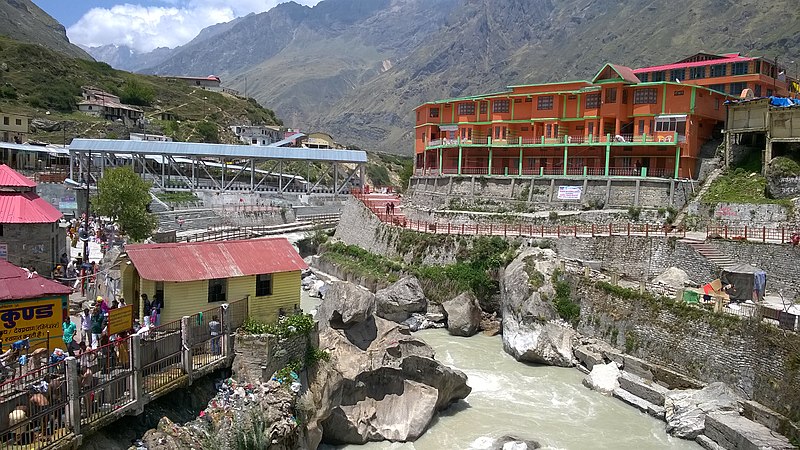
YOU may also like: A complete guide to a weekend road-trip to Srisailam
How to book for online pooja in Badrinath
Thousands of pilgrims visit Badrinath Dham every day. At this temple, pilgrims perform various Poojas. The poojas in Badrinath are of various types and have predetermined rates. All poojas are performed with great care and reverence by devoted priests.
There is great news for pilgrims who can’t make it to Badrinath. Devotees can now book Pooja / Bhog / Paath / Aarti in advance online at a reasonable price. The temple offers several types of Pooja Paath, Aarti and Bhog services. Pilgrims could either book online their slots to be physically available at the time of Pooja , or they could book online Pooja to be done on their behalf at the temples.
It is very simple to book Poojas in Badrinath temple online in advance. Devotees can book Pooja/ Bhog/ Paath/ Aarti at the Badrinath temple by following a few simple steps. Pilgrims must pay online for the services, which will be performed on their behalf by temple authorities in accordance with the rituals.
Booking online puja in Badrinath temple is a fairly simple process. To begin, register on the Badri-Kedar website, log in, and then select Puja/Bhog/Paath/Aarti. Make an online payment after entering your information correctly.
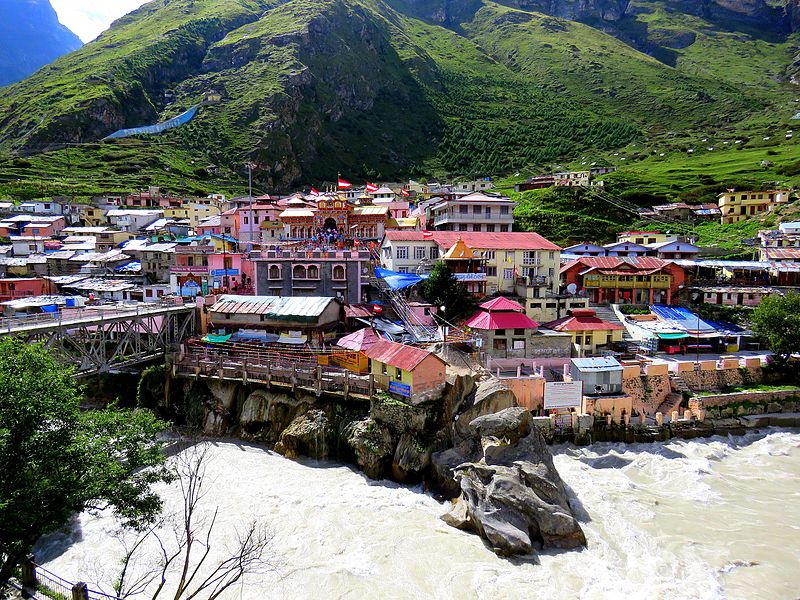
Festivals observed at Badrinath temple
Badri-Kedar festival: As the name suggests Badri-Kedar Festival is held in both Badrinath and Kedarnath. The festival is held every year in June. The Badri Kedar Festival is an 8 days extravaganza and invites artists from all over India to exhibit their work. This is one of the most popular festivals in Uttarakhand.
Cultural programmes, such as musical performances, classical songs, and folk songs, are the main features of the festival.
Mata Murti Ka Mela: This is yet another important festival in Badrinath. Shri Badrinathji’s mother is worshiped on the day of Mata Murti Ka Mela, and a large fair is held at the Badrinath Temple in September. Lord Badrinarayan is taken in a grand procession to meet his mother.
Thus the temple is closed for a day on Bamana Dwadashi when the festival is celebrated. According to the puranas, it was on this day that the river Ganges descended from heaven, bringing life and prosperity to us mortals.
Diwali or the kapat closing ceremony: It is customary that the door of Badrinath shrine must close for devotees and pilgrims for winters from Diwali day. The shrine remains closed for the next six months due to harsh weather and Lord Badrinarayan is shifted to Joshimath, 45 kms from Badrinath.
Diwali which is also the yearly kapat closing ceremony of the shrine is celebrated with all pomp and gaiety. The temple is decorated with bright lights and flowers as the Lord’s six months stint at the shrine comes to an end. An akhanda jyoti is lit during the ceremony which keeps burning till the next six months when the kapat of the temple is reopened to the public.
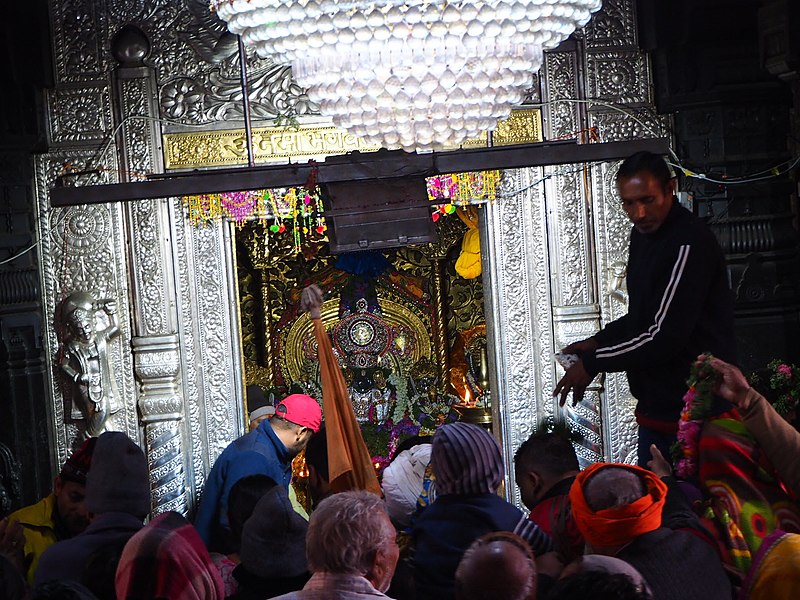
Recommended Read: Visiting Taratarini Temple, the Adi Shakti Peetha in Odisha
Darshan of Lord Badrinarayan
The main purpose of almost all who visit Badrinath is to have darshan of Lord Badrinarayan, the presiding deity of the shrine. For this you have to stand in a queue. When you have reached the sanctum sanctorum, you can notice Lord Badrinarayan, the temple’s 1 meter tall black stone idol, is sitting in a meditative pose rather than his usual reclining pose, under a badri tree and canopy of pure gold.
Within the temple premises, there are idols of 15 other deities, some in the inner sanctum and others outside. Uddhava (Lord Krishna’s devotee), Garuda (Lord Vishnu’s vehicle), Kuber (the god of wealth), Lord Ganesh, Nara and Narayana, Shridevi and Bhudevi, and Goddess Lakshmi are among them.
Tapt Kund, a medicinal hot sulphur spring beneath the temple, is also open to pilgrims before they enter. You must take a bath here before going for darshan. Darshan at Badrinath is usually hassle-free. But, if you want to avoid crowds, then you should plan your visit in September-October instead of May-June.
Places of interest near Badrinath temple
After you are done with the darshan of Lord Badrinarayan, now it is time to explore Badrinath. The holy town is filled with places which make for a mandatory visit. All these are sacred places and each have a story to tell. Moreover, they all are within walking distance from the temple. Here, I have picked up only a few of them which you must visit.
Brahma Kapal : Brahma Kapal is a religious site near Badrinath shrine where Lord Brahma is said to still exist. It is said that those who perform funeral rituals for the deceased in their family achieve Nirvana. You can see people from across the country come to this sacred site to immerse the ashes of a deceased family member in the Alaknanda River, on the banks of which Brahma Kapal is located.
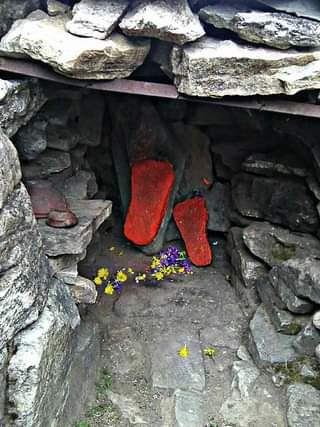
Charanpaduka: Charanpaduka, located 3 kilometres from Badrinath, is a rock with imprints of what are believed to be Lord Vishnu’s footprints. It can be reached after a long trek. You can see hundreds of pilgrims and tourists visit this boulder stone, which is considered a religious site. People believe that Lord Vishnu first set foot on Earth here.
Charan Paduka is located on Narayan Parvat and you can hike up to the hill, which will take you about 1.5 hours. The etymology immediately draws one’s attention to an extraordinary being who must have trekked on this path, leaving eternal imprints of his feet, as charan means feet and paduka means imprints.
Sheshnetra: Sheshnetra is a massive rock near Badrinath known for its religious significance. Lord Vishnu is said to have taken refuge on Ananta Shesha. The genuine imprint is thought to be on a boulder marked with Ananta Shesha’s eye. Sheshanetra is also said to guard the region and Lord Badrinath’s shrine. This apart, the scenic beauty of the location draws a large number of tourists each year.
Narad Kund: Narad Kund is a holy site near Badrinath on the Alaknanda River’s recess. It is said that Adi Sankaracharya recovered Lord Vishnu’s idol from this kund. Before visiting the Badrinath Temple, devotees take a dip in Narad Kund.
The Narad Kund is located near the Tapt Kund and receives hot water from Gauri Shila. It is named after Narad Muni, who wrote the Narada Bhakti Sutra here. Narad Kund’s beautiful surroundings and mythological significance draw a large number of visitors all year.

Tapt Kund: This is another hot water spring located quite close to Badrinath temple. Tapt Kund, believed to be Lord Agni’s home, is a natural hot water spring that heats to 45 degrees Celsius. Visitors take therapeutic baths here on the Alaknanda riverbank. The kund water is thought to have medicinal properties, curing several skin diseases. Before visiting the Badrinath Temple, devotees take a dip in the Tapt Kund.
Pilgrims flock to this Kund, known as the Agni Teerth, to be cleansed of their sins. The Kund’s thermal energy is said to be much greater than that of most water bodies, and it is mythologically believed to have originated from Lord Shiva’s Kapala (forehead). The kund has separate bathing areas for men and women.
Mata Murti Temple: Mata Murti Temple is a sacred Hindu temple in Badrinath dedicated to the mother of twin brothers, Lord Badrinath and Nara. Lord Badrinath is also known as Narayan. According to mythological accounts Mata Murti is said to have prayed to Lord Vishnu and asked him to take birth from her womb as his next incarnation.
Lord Vishnu, pleased with her devotion, took birth as twins. As a result, praying to the Goddess is thought to deliver one from the sufferings of materialistic life. Every year in September, on the day of Shravan Dwadashi, a fair is held at the temple to honour the Goddess.
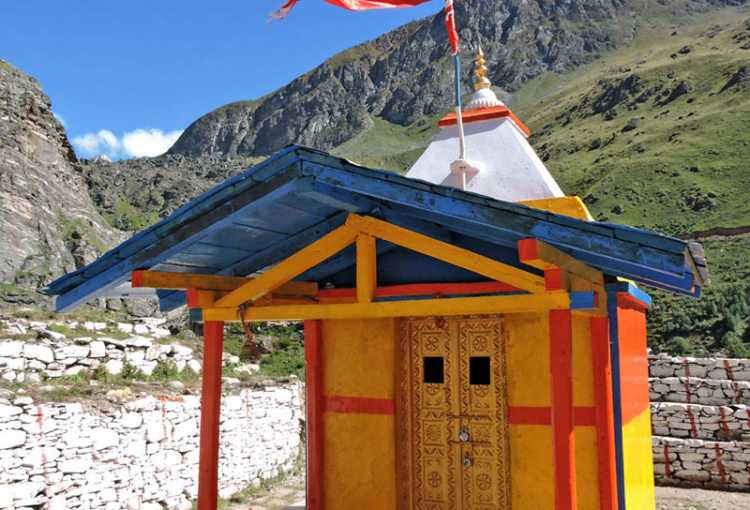
Must Read: Bhojeshwar temple: The unfinished masterpiece of Bhopal
Badrinath FAQs
Yes, it is safe to travel to Badrinath. Here are a few things to keep in mind. As a revered pilgrimage site, Badrinath attracts a large number of tourists each year during the Yatra season. As a result, it is necessary to be cautious of your belongings. The monsoon season should be avoided because the roads leading to Badrinath are prone to landslides.
Badrinath or Badrinarayan Temple is a Hindu temple dedicated to Vishnu which is situated in the town of Badrinath in Uttarakhand. It is one of the Char Dham Temples dedicated to Lord Vishnu in India, and one of the sacred Char Dhams of Uttarakhand.
To explore Badrinath and its nearby surroundings at a relaxed pace, one would need 2 days minimum as there are plenty of places in and around Badrinath. Few of the must visit places are Mana Village, Vasudhara Falls, Tapta Kund, Bheem Pul etc.
Dedicated to Lord Vishnu, the Badrinath Temple is one of the most important pilgrimage sites in India. It is among the four holy places or char dham, which are much revered by Hindus. Devotees undertake a strenuous journey through the mighty Himalayas to reach this holy shrine.

